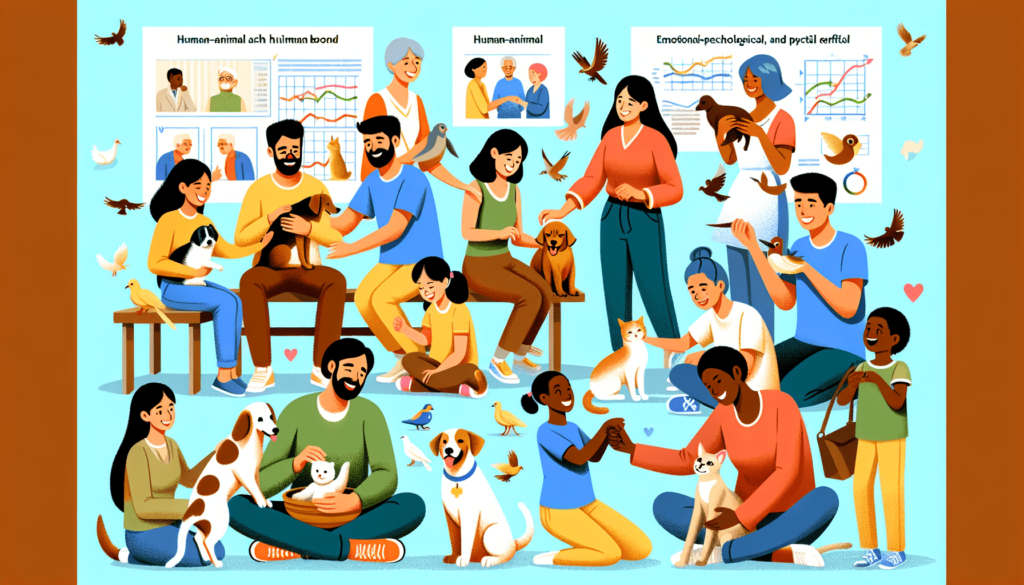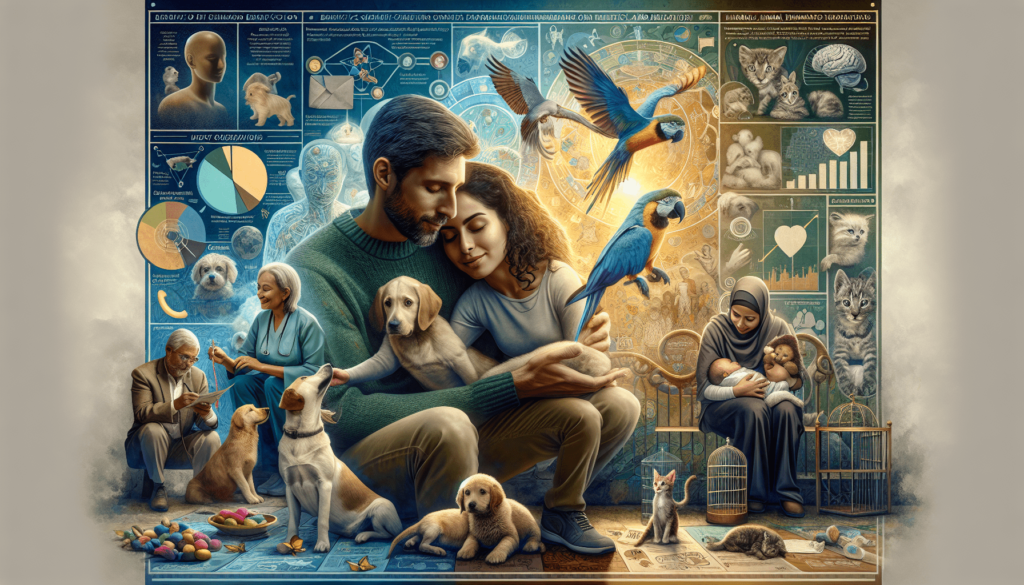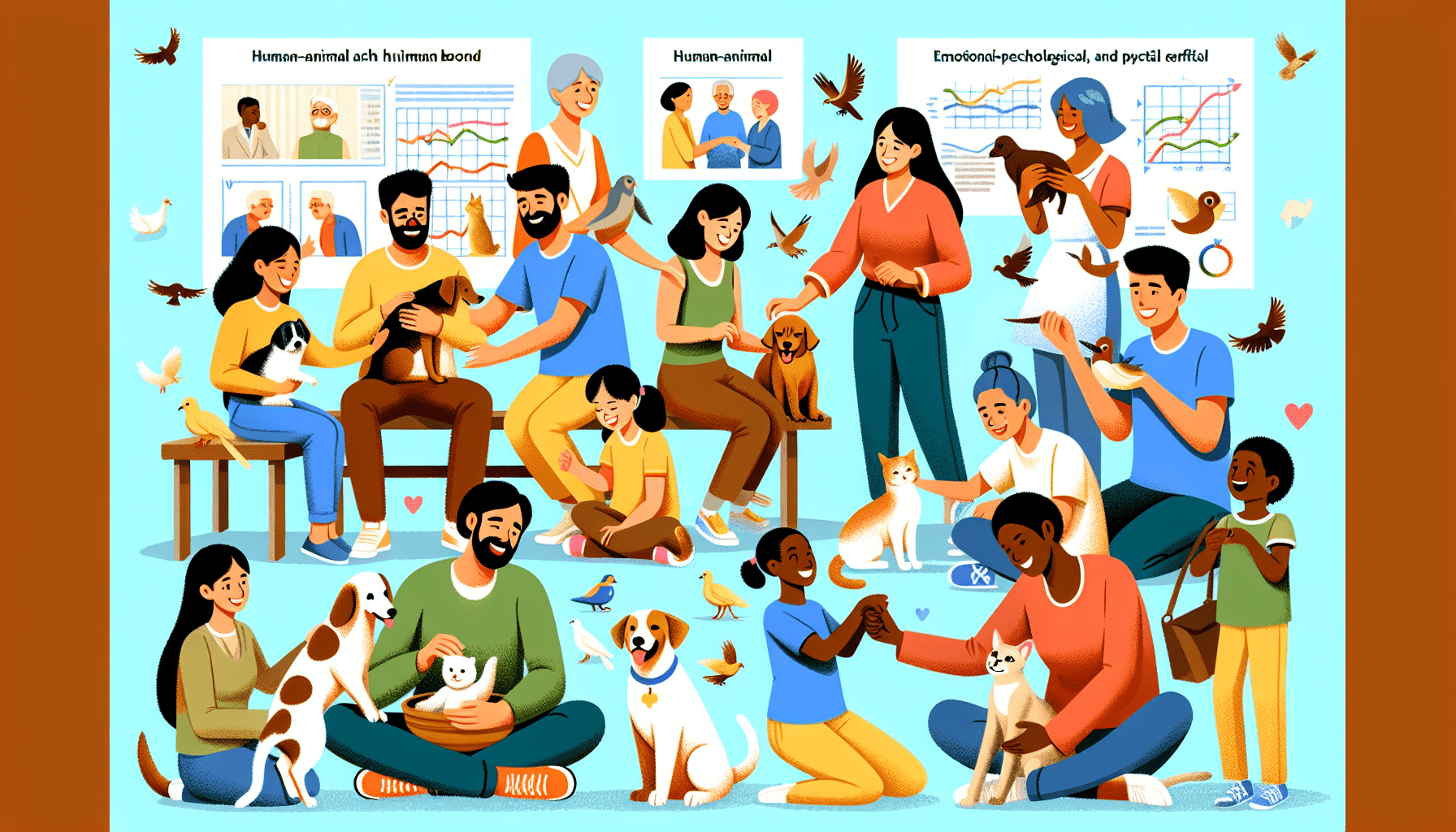Imagine a world where our furry friends are more than just pets – they are cherished family members and constant companions. This article explores the incredible dynamics of human-animal bonding, delving into the unbreakable connection and profound impact that animals can have on our lives. From the unconditional love they offer to the emotional support they provide, this exploration will shed light on why our beloved pets hold such a special place in our hearts. Get ready to be captivated by the fascinating world of human-animal bonding.
Understanding Human-Animal Bonding
Definition and Importance of Human-Animal Bonding
Human-animal bonding refers to the deeply emotional and mutually beneficial relationship that occurs between humans and animals. It is a special connection that transcends the normal interactions between different species, filling a void within our lives and bringing immense joy and fulfillment. This bond has been an integral part of human history, and its importance cannot be overstated.
The significance of human-animal bonding lies in its ability to enhance our overall well-being and quality of life. Animals have a unique way of providing companionship, comfort, and unconditional love that is often difficult to find elsewhere. They can help reduce stress, anxiety, and loneliness, while also promoting a sense of purpose and responsibility.
Psychological and Emotional Benefits of Human-Animal Bonding
The psychological and emotional benefits of human-animal bonding are numerous and remarkable. Pets, in particular, have been shown to have a positive impact on mental health. They can help alleviate symptoms of depression and anxiety, providing a constant source of emotional support and stability. The presence of an animal companion has been linked to increased self-esteem, improved mood, and a greater sense of overall happiness.
The act of interacting with animals also triggers the release of oxytocin, a hormone associated with bonding and feelings of love and affection. This hormonal response contributes to the soothing and calming effect that animals can have on humans, further deepening the bond between them. The companionship provided by animals can also reduce feelings of social isolation by offering a source of connection and understanding.
Signs of a Strong Human-Animal Bond
A strong human-animal bond can be identified through various signs and behaviors exhibited by both the human and the animal. For the human, it may involve a deep sense of affection and love for the animal, a willingness to prioritize their needs and well-being, and a desire to spend quality time together. The human may also feel a strong sense of responsibility and protectiveness towards the animal.
On the animal’s part, signs of a strong bond may include seeking out the human’s attention and affection, displaying signs of excitement and happiness upon their return, and exhibiting a sense of trust and relaxation in their presence. The animal may also show a willingness to obey commands and follow the human’s lead, indicating a deep level of communication and understanding.
Factors Influencing Human-Animal Bonding
Species and Breed
The species and breed of the animal can play a significant role in shaping the human-animal bond. Different species and breeds have distinct characteristics and temperaments, which can impact compatibility and the ability to form a strong bond. For example, some individuals may find that they have a natural affinity for dogs, while others may have a stronger connection with cats or birds. It is important to consider personal preferences and lifestyle factors when choosing a companion animal.
Age and Life Stage
Age and life stage also contribute to the dynamics of human-animal bonding. Puppies and kittens, for instance, may require more time and effort in terms of training and socialization, but they can also provide a unique opportunity to shape the bond from an early age. Older animals, on the other hand, may already possess certain behaviors and traits that can either enhance or challenge the development of the bond. Matching the age and life stage of the animal with the individual’s preferences and capabilities is crucial for a successful bond.
Individual Personality and Compatibility
The individual’s personality and compatibility with the animal are important factors in determining the strength of the bond. Some individuals may naturally gravitate towards animals that possess qualities that align with their own personality traits. For example, an energetic and active person may find a lively and playful dog to be a perfect match, while a calm and introverted person may prefer the company of a relaxed and independent cat. Building a bond is easier when there is a sense of mutual understanding and connection between the human and the animal.
Previous Experience with Animals
Previous experience with animals can also influence the development of the human-animal bond. Individuals who have had positive experiences with animals in the past may be more inclined to form strong bonds with future animal companions. On the other hand, negative experiences or traumas involving animals can create barriers to bonding and trust. Understanding and addressing any past experiences is essential for fostering a healthy and nurturing bond.

Development of Human-Animal Bonding
Early Interactions and Socialization
The development of the human-animal bond begins with early interactions and socialization. For puppies and kittens, this involves exposing them to a variety of environments, people, and animals in a positive and controlled manner. By doing so, they learn to feel safe and comfortable in different situations, which lays the foundation for a secure bond. Early socialization also helps animals develop important social and communication skills, enabling them to navigate their interactions with humans effectively.
Attachment and Bond Formation
Attachment and bond formation occur as the human and animal spend time together and establish a sense of trust and familiarity. This process is facilitated by engaging in activities that promote bonding, such as engaging in play, grooming, and feeding. Through these shared experiences, both the human and the animal learn to rely on each other for emotional support and companionship, solidifying the bond.
Mutual Trust and Communication
Mutual trust and effective communication are fundamental to a strong human-animal bond. Trust is built over time through consistent and reliable interactions, where both the human and the animal feel safe and secure in each other’s presence. Communication plays a crucial role in understanding each other’s needs and desires. Animals communicate through body language, vocalizations, and other means, while humans often use verbal and non-verbal cues. Establishing clear and effective channels of communication fosters a deeper understanding and connection.
Maintaining and Strengthening the Bond
Maintaining and strengthening the human-animal bond requires ongoing effort and attention. Regular positive interactions and engaging in activities that both the human and the animal enjoy are essential. This can involve spending quality time together, participating in training sessions or games, and providing enrichment and stimulation. Consistency, patience, and understanding are key in nurturing and deepening the bond over time.
Types of Human-Animal Bonding
Companion Animals and Pet Ownership
One of the most common forms of human-animal bonding is through companion animals and pet ownership. This involves bringing animals into our homes and lives as family members or friends. Pets provide companionship, emotional support, and a sense of purpose. They offer love and loyalty without judgment, enriching our lives in countless ways.
Assistance and Service Animals
Assistance and service animals are another type of bonding that serves a specific purpose. These animals are trained to perform tasks or provide support to individuals with disabilities or special needs. Service dogs, for example, assist individuals with mobility limitations, while therapy animals help improve emotional and physical well-being through targeted interventions. The bond between these animals and their handlers is built on trust, teamwork, and a shared goal of overcoming obstacles.
Therapy Animals and Animal-Assisted Interventions
Therapy animals play a vital role in various settings, such as hospitals, nursing homes, and schools. They provide comfort, companionship, and emotional support to individuals who may be facing physical or emotional challenges. Animals involved in animal-assisted interventions are specially trained to interact with people in a therapeutic and healing capacity. The bond formed between therapy animals and those they assist is based on empathy, trust, and the power of unconditional love.
Working Animals and Human-Animal Partnerships
Working animals, such as search and rescue dogs, police dogs, and guide dogs, form unique partnerships with humans. These animals undergo specialized training to perform tasks that contribute to the safety, security, and well-being of individuals and communities. These partnerships are characterized by a high level of trust, mutual respect, and a shared mission to fulfill specific duties and responsibilities.

Challenges in Human-Animal Bonding
Allergies and Health Concerns
Allergies and health concerns can pose challenges to human-animal bonding. Some individuals may have allergic reactions to certain animals, making it difficult to maintain a close bond. Additionally, health concerns related to an animal’s well-being, such as chronic illnesses or behavioral issues, can impact the strength of the bond. Addressing these challenges requires open communication, proactive management, and seeking professional help when needed.
Life Changes and Adjustments
Life changes and adjustments can also impact the human-animal bond. Major life events, such as moving, getting married, or having children, may require adjustments in the relationship dynamics between the human and the animal. It is essential to consider the well-being of the animal during these transitions and to provide the necessary support and care to maintain a healthy bond.
Loss and Grief
Loss and grief are inevitable parts of the human-animal bond. The death of an animal companion can be devastating, causing immense sorrow and grief. The loss of the bond can leave a void that may take time to heal. Grieving is a natural and important process, and it is essential to seek support and understanding from others who have experienced a similar loss.
Behavioral and Training Issues
Behavioral and training issues can strain the human-animal bond. Animals may exhibit unwanted behaviors or struggle with certain training tasks, which can create frustration and disappointment. Patience, consistency, and using positive reinforcement techniques can help overcome these challenges and strengthen the bond. Seeking professional guidance from trainers or behaviorists can also be beneficial.
Promoting a Healthy Human-Animal Bond
Education and Awareness
Promoting a healthy human-animal bond starts with education and awareness. Providing information about responsible pet ownership, the needs of different animal species, and the benefits of positive interactions can help individuals make informed decisions and cultivate a nurturing bond. Educational programs and community initiatives can play a crucial role in spreading awareness and knowledge.
Positive Reinforcement Training
Positive reinforcement training is a key element in fostering a healthy bond between humans and animals. This training method focuses on rewarding desired behaviors rather than punishing unwanted behaviors, creating a positive and cooperative learning environment. By using rewards such as treats, praise, and play, humans can effectively communicate with their animals, build trust, and enhance the bond.
Regular Veterinary Care
Regular veterinary care is essential for maintaining the health and well-being of animals and ensuring a strong bond. Routine check-ups, vaccinations, and preventive treatments can help prevent illnesses and detect potential health issues early. Regular visits to the veterinarian also provide an opportunity to address any concerns or questions relating to the animal’s behavior or overall welfare.
Exercise and Enrichment
Physical exercise and mental enrichment are vital for a healthy and thriving human-animal bond. Animals require appropriate stimulation and engagement to keep them mentally and physically fit. Engaging in activities such as daily walks, interactive play sessions, and puzzle toys can provide the necessary outlets for energy and prevent boredom. These shared experiences contribute to the overall satisfaction and bond between humans and animals.
Ethical Considerations in Human-Animal Bonding
Animal Welfare and Responsibility
Ethical considerations in human-animal bonding revolve around ensuring the welfare and well-being of animals. It is essential to prioritize their physical and emotional needs, providing appropriate nutrition, healthcare, and living conditions. Responsible pet ownership includes providing a safe environment, regular exercise, mental stimulation, and socialization opportunities.
Respecting Animal Boundaries
Respecting animal boundaries is crucial for maintaining a healthy and balanced bond. Animals have their own preferences and limits, and it is important to recognize and respect them. Learning to interpret their body language and cues allows humans to understand their boundaries and provide the necessary space when needed. Respecting boundaries fosters trust and demonstrates a commitment to the animal’s comfort and well-being.
Avoiding Exploitation and Abuse
Exploitation and abuse have no place in the human-animal bond. Animals should never be used for personal gain, entertainment, or subjected to any form of cruelty. It is our responsibility to protect and advocate for their rights, ensuring a safe and nurturing environment. Recognizing and reporting any signs of abuse is essential in promoting a healthy and ethical bond.
Balancing Human Needs with Animal Needs
Balancing human needs with animal needs is an important ethical consideration in human-animal bonding. It is necessary to find a balance between our desires and the welfare of the animal. This involves ensuring that the animal’s physical, emotional, and behavioral needs are met while still considering our own lifestyle and capabilities. Making decisions that prioritize the long-term well-being of the animal demonstrates a commitment to fostering a healthy and sustainable bond.
The Impact of Human-Animal Bonding on Society
Health Benefits and Healing Effects
The impact of human-animal bonding extends beyond the individual level and positively influences society as a whole. Numerous studies have shown the significant health benefits associated with human-animal interactions, such as lowered blood pressure, reduced heart rate, and decreased stress levels. These effects have implications for public health and contribute to overall well-being.
Enhancing Well-being and Quality of Life
Human-animal bonding enhances well-being and quality of life for both humans and animals. Animals provide companionship, love, and purpose, improving feelings of happiness and overall life satisfaction. The presence of animals in communities and public spaces can create a sense of connection and unity, fostering a positive social environment.
Supporting Mental Health and Social Connections
Human-animal bonding plays a crucial role in supporting mental health and social connections. Animals act as a source of emotional support, reducing feelings of loneliness and isolation. They can also serve as facilitators of social interactions, breaking down barriers and creating opportunities for human interaction and connection. Animals have been shown to improve social skills, self-confidence, and empathy in individuals of all ages.
Promoting Environmental Stewardship
The bond between humans and animals promotes environmental stewardship and a greater appreciation for the natural world. Through the companionship and interactions with animals, individuals develop a deeper understanding of their role in protecting and preserving the environment. This awareness contributes to a more sustainable and compassionate society.
Scientific Research on Human-Animal Bonding
Studies on the Power of Animal Companionship
Scientific research has extensively explored the power of animal companionship on human well-being. Numerous studies have confirmed the positive impact of pet ownership on mental health, such as reduced stress, increased social support, and improved psychological well-being. The presence of animals has also been linked to enhanced cognitive function, lower rates of depression, and improved overall quality of life.
Neurochemical and Physiological Effects
Studies have also investigated the neurochemical and physiological effects of human-animal bonding. Interactions with animals have been found to increase levels of oxytocin, cortisol, and beta-endorphins, which are hormones associated with bonding, stress reduction, and pain relief. These effects have been observed in both humans and animals, highlighting the reciprocal nature of the bond.
The Role of Attachment Theory
Attachment theory provides a framework for understanding the dynamics of human-animal bonding. Just as humans form attachment bonds with other humans, they can also form attachment bonds with animals. This theory explains the emotional bonds that develop between individuals and their animal companions, emphasizing the importance of feelings of security, trust, and emotional availability.
Exploring the Evolutionary Basis
Researchers have also explored the evolutionary basis of human-animal bonding. Some theories suggest that the bond between humans and animals stems from our shared evolutionary history. Early humans may have formed alliances with animals for protection, hunting, and companionship, leading to the development of a deep emotional bond that persists to this day.
Conclusion
Recognizing the transformative power of human-animal relationships is crucial in fostering healthy and meaningful bonds. Nurturing these bonds for mutual benefit requires understanding the factors influencing bonding, promoting a healthy and ethical environment, and recognizing the positive impact on individuals and society. Continued exploration and advancement in the field of human-animal bonding will contribute to our understanding of this intricate relationship, enriching the lives of both humans and animals alike.

